Solar eclipse of October 22, 1911
An annular solar eclipse occurred on October 22, 1911. A solar eclipse occurs when the Moon passes between Earth and the Sun, thereby totally or partly obscuring the image of the Sun for a viewer on Earth. An annular solar eclipse occurs when the Moon's apparent diameter is smaller than the Sun's, blocking most of the Sun's light and causing the Sun to look like an annulus (ring). An annular eclipse appears as a partial eclipse over a region of the Earth thousands of kilometres wide. Annularity was visible from the Russian Empire (the parts now belonging to Kazakhstan, Uzbekistan and Kyrgyzstan), China, French Indochina (the part now belonging to Vietnam), Philippines, Dutch East Indies (today's Indonesia), Territory of Papua (now belonging to Papua New Guinea) including the capital city Port Moresby, and British Western Pacific Territories (the parts now belonging to Solomon Islands and Tuvalu, including the city of Honiara and Tulagi).
| Solar eclipse of October 22, 1911 | |
|---|---|
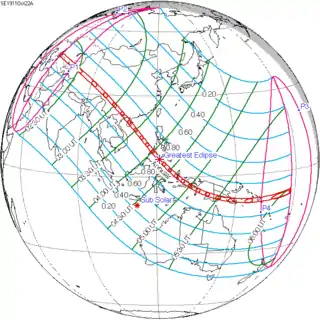 Map | |
| Type of eclipse | |
| Nature | Annular |
| Gamma | 0.3224 |
| Magnitude | 0.965 |
| Maximum eclipse | |
| Duration | 227 sec (3 m 47 s) |
| Coordinates | 6.3°N 121.4°E |
| Max. width of band | 133 km (83 mi) |
| Times (UTC) | |
| Greatest eclipse | 4:13:02 |
| References | |
| Saros | 132 (40 of 71) |
| Catalog # (SE5000) | 9307 |
Related eclipses
Solar eclipses of 1910–1913
This eclipse is a member of a semester series. An eclipse in a semester series of solar eclipses repeats approximately every 177 days and 4 hours (a semester) at alternating nodes of the Moon's orbit.[1]
| Solar eclipse series sets from 1910–1913 | ||||
|---|---|---|---|---|
| Ascending node | Descending node | |||
| 117 | May 9, 1910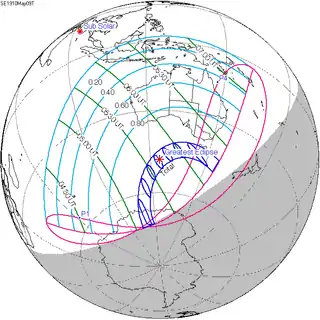 Total |
122 | November 2, 1910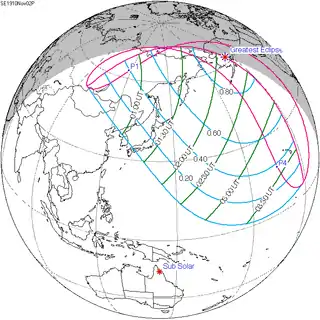 Partial | |
| 127 | April 28, 1911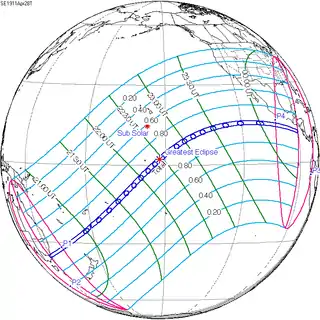 Total |
132 | October 22, 1911 Annular | |
| 137 | April 17, 1912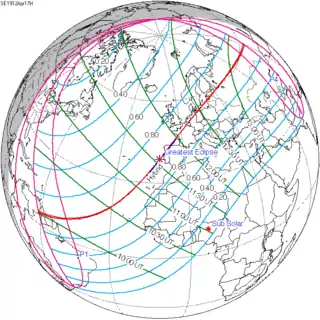 Hybrid |
142 | October 10, 1912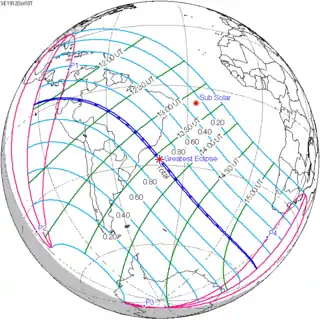 Total | |
| 147 | April 6, 1913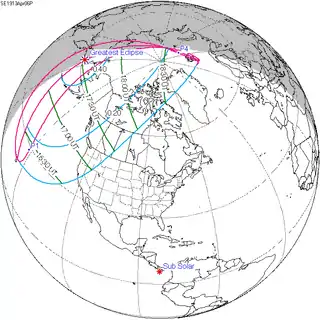 Partial |
152 | September 30, 1913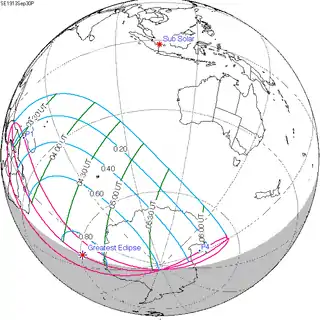 Partial | |
Saros 132
This eclipse is a part of Saros cycle 132, repeating every 18 years, 11 days, containing 71 events. The series started with partial solar eclipse on August 13, 1208. It contains annular eclipses from March 17, 1569 through March 12, 2146, hybrid on March 23, 2164 and April 3, 2183 and total eclipses from April 14, 2200 through June 19, 2308. The series ends at member 71 as a partial eclipse on September 25, 2470. The longest duration of annular was 6 minutes, 56 seconds on May 9, 1641, and totality will be 2 minutes, 14 seconds on June 8, 2290. All eclipses in this series occurs at the Moon’s descending node.
| Series members 28–50 occur between 1690 and 2100: | ||
|---|---|---|
| 28 | 29 | 30 |
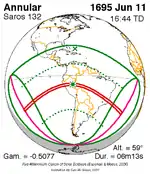 June 11, 1695 |
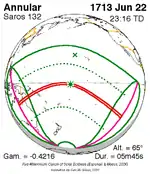 June 22, 1713 |
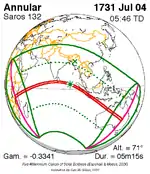 July 4, 1731 |
| 31 | 32 | 33 |
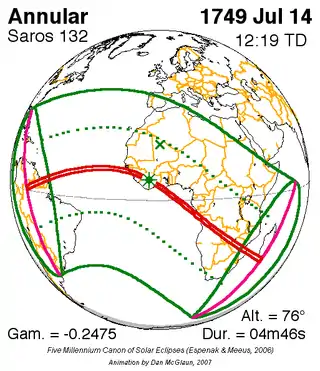 July 14, 1749 |
 July 25, 1767 |
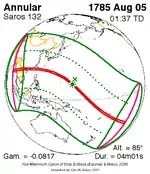 August 5, 1785 |
| 34 | 35 | 36 |
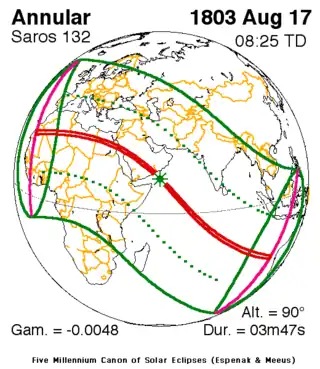 August 17, 1803 |
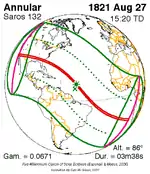 August 27, 1821 |
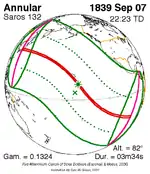 September 7, 1839 |
| 37 | 38 | 39 |
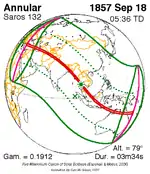 September 18, 1857 |
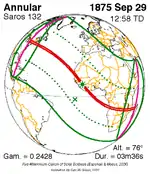 September 29, 1875 |
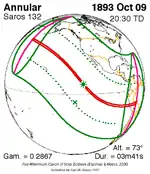 October 9, 1893 |
| 40 | 41 | 42 |
 October 22, 1911 |
 November 1, 1929 |
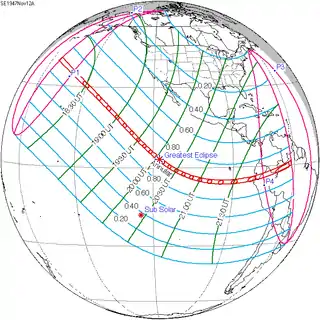 November 12, 1947 |
| 43 | 44 | 45 |
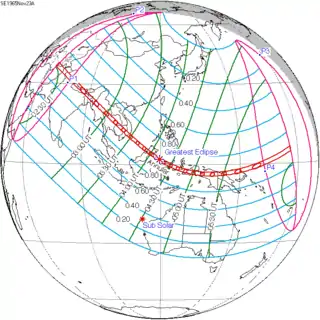 November 23, 1965 |
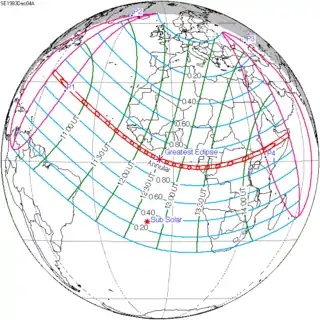 December 4, 1983 |
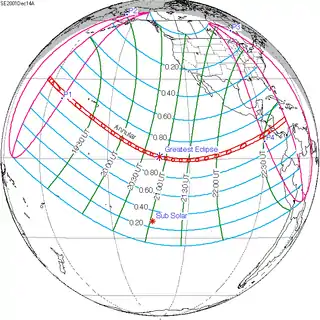 December 14, 2001 |
| 46 | 47 | 48 |
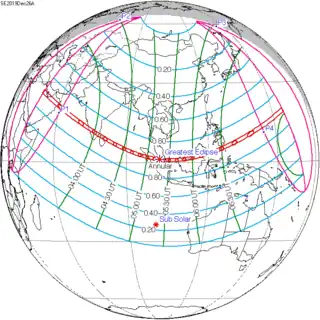 December 26, 2019 |
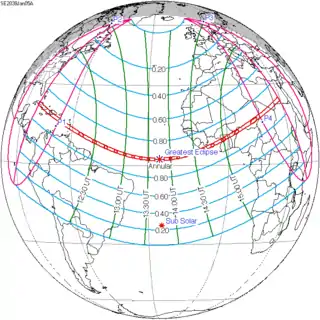 January 5, 2038 |
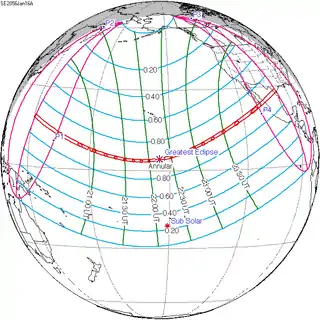 January 16, 2056 |
| 49 | 50 | |
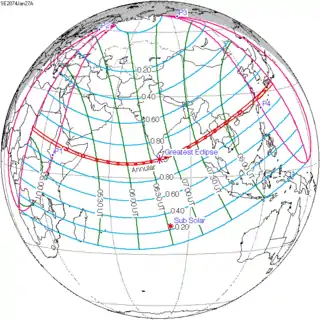 January 27, 2074 |
 February 7, 2092 | |
Notes
- van Gent, R.H. "Solar- and Lunar-Eclipse Predictions from Antiquity to the Present". A Catalogue of Eclipse Cycles. Utrecht University. Retrieved 6 October 2018.
References
- Earth visibility chart and eclipse statistics Eclipse Predictions by Fred Espenak, NASA/GSFC
.jpg.webp)

